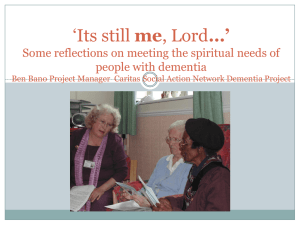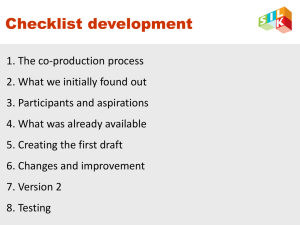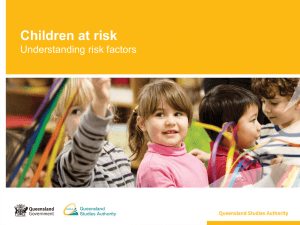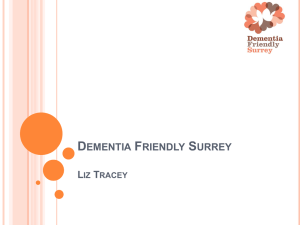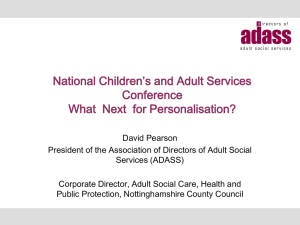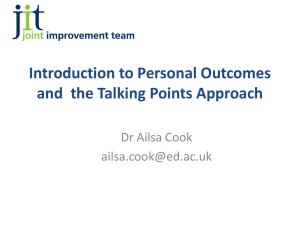Presentation (Powerpoint)
advertisement
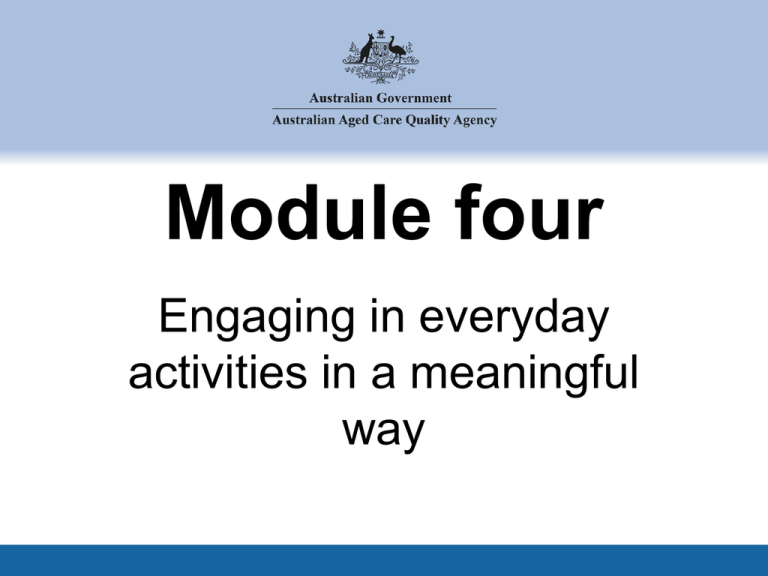
Module four Engaging in everyday activities in a meaningful way 4. Meaningful engagement This section covers: 4.1 What are activities in effective care? 4.2 Tailoring everyday activities 4.3 Assisting a person to engage 1 Learning outcomes At the end of this session you will be able to: • define the concept of activity and its purpose • work with families to discover meaningful activities for people with dementia • identify appropriate activities that meet a person’s needs and abilities • recognise the difference between structured and unstructured activities • set up the environment to encourage safe participation in activities • break down activities into single steps or tasks. 2 4.1 What are activities in effective care? • They are not always recreational or diversional • They should be part of a normal day • They should hold meaning & purpose for the unique person • They should be pleasurable & aim • to engage the person with life 3 Activity’ covers a vast number of daily activities • Domestic activity ‘ • Self care • Work • Leisure 4 Why is engaging in meaningful activities important? • Feel useful • Maintain: – skills – health – independence – self-esteem • Experience pleasure • Reflect spiritual & cultural identity 5 4. 2 Tailoring everyday activities Centre on the person • • When we centre on the person we find activities that provide meaning and purpose An assessment process allows us… • to explore retained abilities and skills • to discover an individual’s history (likes and dislikes, past roles and routines) • to consider the person’s cultural and spiritual background 6 Accept the impact of brain damage Frontal Lobe Parietal Lobe Planning, organizing, judging, initiating, insight Patterns (putting together the steps to complete a task), communication (written and verbal), spatial awareness Temporal Lobe Limbic System Filing system, memory (Connecting system) Sleep, appetite, emotions 7 Respect the person with dementia • Treat the person as an adult • Involve the person in meaningful and purposeful activity • Be patient, flexible, creative, reassuring and encouraging 8 Enable the person through… Our caring relationship and physical and social environment will : • Maintain skills and abilities • Provide opportunities for individual’s growth • Maintain safety and feelings of security 9 4.3 Assisting a person to engage Tools that we can use: • Breaking things up into smaller steps – ‘Step by step’ (called Activity or Task Analysis) • Go step by step using ‘Prompt, Guide, and assist’ (using graded assistance) 10 Step by step (task analysis) • Break activity/task into small steps • Give the least restrictive prompt to enable activity/task completion • Smile, encourage and give praise • Allow person to proceed at their own pace. 11 Non-Directive Prompt Directive Prompt Modelling required action Physical Assist Fully Assist Prompts and Guidance Graded assistance REMEMBER: Make the most of a person’s skills and abilities! Task analysis allows each person to… • Maintain independence • Maintain existing skills • Maintain dignity • Maximise the possibility of success 13 Preparation for an activity – 5 ‘S’s • Set up – make prior preparations, have things ready or set up • Say it - explain what is about to happen • Show it – point and demonstrate • Start with a Smile – “can you help me?” 14 Balance safety/comfort with independence All people have a right to… • Be safe • Be comfortable • Maintain independence • Maintain existing skills • Make informed decisions Finding the balance can be challenging 15 Structured activities • Assisting with makeup/hair • Bus trips • Church service • Showering • Crosswords • Gardening • Making a cup of tea (domestic) 16 Unstructured (half done) activities • Chair placed to look out onto bird feeder • Garden tools accessible to encourage gardening • Unfinished knitting • Open magazines • Basket of washing left to hang on the line/fold • Broom handy to sweep floors 17 Individually tailored activity Designing and assisting a person with an individually tailored activity • Personal history (centre) • Likes and dislikes (centre) • Culture (centre) • Safety and comfort (accept limitations) • Disabilities (i.e. visual impairment) (accept health) • Communication (respect) • Safety and comfort (accept limitations) • Enabling environment (enable) 18 Partnerships with family carers Why are partnerships with family carers so important in dementia care? Partnerships with family carers are crucial for: • Achieving our mission (quality of life for each person) • Meeting our core challenge (knowing & honouring each individual’s uniqueness through how we care) 19 How family carers can help … … you engage people with dementia Assist with achieving high quality care through sharing what they have LEARNED THROUGH CARING: • the meaning of mannerisms and behaviour • how to care well • strategies for resolving problems 20 How family carers can help you … … engage a person with dementia • Improve quality of life – Create pleasure & enjoyment – Meet emotional & individual needs – Identify issues & problems early • Provide vital information about the person: – Assets (social, personal) – Interests, routines and activities – Shared history 21 Key Messages 1. Activities are everyday not just recreational 2. Activities that engage are meaningful to the person and tailored to their needs 3. Memory is not essential to enjoyment 4. Assist engagement by a step by step approach 5. Balance comfort/safety with independence REMEMBER … Make the most of the client’s abilities and go at their pace not your pace and use all your communication skills 22
